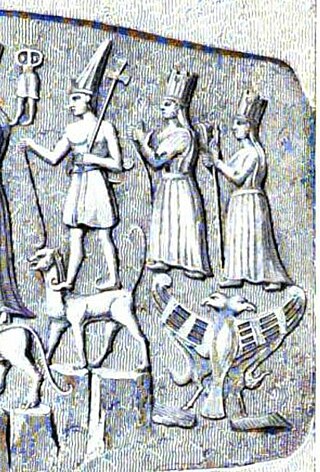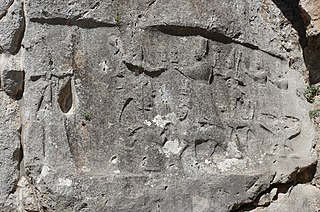
The Hittites were an Anatolian people who played an important role in establishing first a kingdom in Kussara, then the Kanesh or Nesha kingdom, and next an empire centered on Hattusa in north-central Anatolia. This empire reached its height during the mid-14th century BC under Šuppiluliuma I, when it encompassed an area that included most of Anatolia as well as parts of the northern Levant and Upper Mesopotamia.

The Hurrians were a people of the Bronze Age Near East. They spoke a Hurrian language and lived in Anatolia, Syria and Northern Mesopotamia. The largest and most influential Hurrian nation was the kingdom of Mitanni, its ruling class perhaps being Indo-Aryan speakers. The population of the Hittite Empire in Anatolia included a large population of Hurrians, and there is significant Hurrian influence in Hittite mythology. By the Early Iron Age, the Hurrians had been assimilated with other peoples. The state of Urartu later covered some of the same area.

Yamata no Orochi, or simply Orochi (大蛇), is a legendary eight-headed and eight-tailed Japanese dragon/serpent.

Teshub was the Hurrian god of sky, thunder, and storms. Taru was the name of a similar Hattic storm god, whose mythology and worship as a primary deity continued and evolved through descendant Luwian and Hittite cultures. In these two, Taru was known as Tarhun / Tarhunt- / Tarhuwant- / Tarhunta, names derived from the Anatolian root *tarh "to defeat, conquer". Taru/Tarhun/Tarhunt was ultimately assimilated into and identified with the Hurrian Teshub around the time of the religious reforms of Muwatalli II, ruler of the Hittite New Kingdom in the early 13th century BCE. These reforms can generally be categorized as an official incorporation of Hurrian deities into the Hittite pantheon, with a smaller number of important Hurrian gods being explicitly identified with preexisting major Hittite deities. Teshub reappears in the post-Hurrian cultural successor kingdom of Urartu as Tesheba, one of their chief gods; in Urartian art he is depicted standing on a bull.

In Hittite mythology, Illuyanka was a serpentine dragon slain by Tarḫunz, the Hittite incarnation of the Hurrian god of sky and storm. It is known from Hittite cuneiform tablets found at Çorum-Boğazköy, the former Hittite capital Hattusa. The contest is a ritual of the Hattian spring festival of Puruli.

Šarruma or Sharruma was a Hurrian mountain god, who was also worshipped by the Hittites and Luwians.

Ḫebat or Hepat was a Hurrian goddess. She was the tutelary deity of Halab in origin, and in that role appears already in pre-Hurrian texts from Ebla. Her status was not identical in all Hurrian centers: while she was the main goddess in the pantheons of Halab and various cities of Kizzuwatna, her role in Ugarit and in eastern cities like Nuzi was smaller.
Kumarbi, also known as Kumurwe, Kumarwi and Kumarma, was a Hurrian god. He held a senior position in the Hurrian pantheon, and was described as the "father of gods". He was portrayed as an old, deposed king of the gods, though this most likely did not reflect factual loss of the position of the head of the pantheon in Hurrian religion, but only a mytholoogical narrative. It is often assumed that he was an agricultural deity, though this view is not universally accepted and the evidence is limited. He was also associated with prosperity. It was believed that he resided in the underworld.
Hutena and Hutellura were goddesses of fate and divine midwives in Hurrian mythology.

Hittite mythology and Hittite religion were the religious beliefs and practices of the Hittites, who created an empire centered in what is now Turkey from c. 1600–1180 BC.
Kizzuwatna was an ancient Anatolian kingdom in the 2nd millennium BC. It was situated in the highlands of southeastern Anatolia, near the Gulf of İskenderun, in modern-day Turkey. It encircled the Taurus Mountains and the Ceyhan River. The centre of the kingdom was the city of Kummanni, in the highlands. In a later era, the same region was known as Cilicia.
In Hurrian mythology, Ullikummi is a giant stone monster, son of Kumarbi and the sea god's daughter, Sertapsuruhi, or a female cliff. The language of the literary myth in its existing redaction is Hittite, in cuneiform texts recovered at Bogaskoy, where some Hurrian fragments of the "Song of Ullikummi" have been found. See Guterbock (1951).

Šauška (Shaushka), also called Šauša or Šawuška, was the highest ranked goddess in the Hurrian pantheon. She was associated with love and war, as well as with incantations and by extension with healing. While she was usually referred to as a goddess and with feminine titles, such as allai, references to masculine Šauška are also known. The Hurrians associated her with Nineveh, but she was also worshiped in many other centers associated with this culture, from Anatolian cities in Kizzuwatna, through Alalakh and Ugarit in Syria, to Nuzi and Ulamme in northeastern Mesopotamia. She was also worshiped in southern Mesopotamia, where she was introduced alongside a number of other foreign deities in the Ur III period. In this area, she came to be associated with Ishtar. At a later point in time, growing Hurrian influence on Hittite culture resulted in the adoption of Šauška into the Hittite state pantheon.
Alalu or Alala was a primordial figure in Mesopotamian and Hurrian mythology. He is also known from documents from Emar. While his role was not identical in these three contexts, it is agreed that all three versions share the same origin.

The Hurrian religion was the polytheistic religion of the Hurrians, a Bronze Age people of the Near East who chiefly inhabited the north of the Fertile Crescent. While the oldest evidence goes back to the third millennium BCE, is best attested in cuneiform sources from the second millennium BCE written not only in the Hurrian language, but also Akkadian, Hittite and Ugaritic. It was shaped by the contacts between Hurrians and various cultures they coexisted with. As a result, the Hurrian pantheon included both natively Hurrian deities and those of foreign origin, adopted from Mesopotamian, Syrian, Anatolian and Elamite beliefs. The culture of the Hurrians were not entirely homogeneous, and different local religious traditions are documented in sources from Hurrian kingdoms such as Arrapha, Kizzuwatna and Mitanni, as well as from cities with sizeable Hurrian populations, such as Ugarit and Alalakh.

Luwian religion was the religious and mythological beliefs and practices of the Luwians, an Indo-European people of Asia Minor, which is detectable from the Bronze Age until the early Roman empire. It was strongly affected by foreign influence in all periods and it is not possible to clearly separate it from neighbouring cultures, particularly Syrian and Hurrian religion. The Indo-European element in the Luwian religion was stronger than in the neighbouring Hittite religion.

Aštabi, also known as Aštabil, was a god worshiped in the third millennium BCE in Ebla, later incorporated into Hurrian beliefs in locations such as Alalakh and Ugarit and as a result also into the religion of the Hittite Empire.

Hittite music is the music of the Hittites of the 17th-12th century BC and of the Syro-Hittite successor states of the 12th-7th century BC.
Kiaše, also spelled Kiaže or Kiyaši was a Hurrian deity representing the sea. Sometimes in modern scholarship, he is simply referred to as "the Sea" or "the Sea God."

Namni and Ḫazzi were two mountain gods who belonged to the Hurrian pantheon. They are usually mentioned together in known texts. Ḫazzi corresponds to Jebel al-Aqra, while the identification of the mountain Namni represented is disputed. Both of them belonged to the court of the Hurrian weather god, Teššub, and it is possible they were worshiped alongside him in Aleppo. They are also attested in a variety of Hurrian and Hittite religious texts. They do not play an active role in known myths of Hurrian origin, though allusions to a conflict involving them have been identified in texts dealing with other deities.